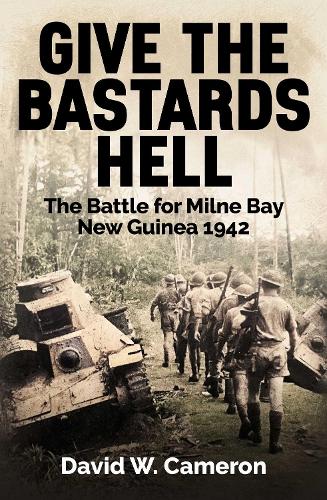
Give the Bastards Hell: The Battle for Milne Bay, New Guinea 1942
(Paperback)
Publishing Details
Give the Bastards Hell: The Battle for Milne Bay, New Guinea 1942
By (Author) David W. Cameron
Big Sky Publishing
Big Sky Publishing
5th March 2025
Australia
Classifications
Non Fiction
Second World War
Land forces and warfare
Battles / military campaigns
Physical Properties
Paperback
440
Width 3886mm, Height 5842mm
Description
In New Guineas jungles, a fierce battle turned the tide of the Pacific Warthe first major land defeat for the unstoppable Japanese forces.
By mid-August 1942, Imperial Japanese forces dominated the Southeast Asian and Pacific theatres, seemingly unstoppable in their advance. While the Japanese South Seas Force pushed north toward Port Moresby along the Kokoda Track, they launched an operation against Milne Bay at the eastern tip of New Guinea. Their objective: to seize the crucial Allied airfields under construction, which would pave the way for capturing Port Moresby and consolidating their hold on the region.
For two intense weeks, Japanese marines, supported by tanks and naval bombardments, battled through the jungle-covered strip of land between the beaches and mountains. Facing them was a determined and diverse Allied forceAustralian militia, 2nd AIF troops, American engineers, and, critically, Australian fighter pilotswho fought the Japanese to a standstill near the partially completed Air Strip No. 3. Despite desperate human wave attacks by the Japanese, the Allies held their ground.
When the smoke cleared, the Japanese had suffered their first significant land defeat since Pearl Harbor. The Battle of Milne Bay marked a turning point in the Pacific War, signalling the beginning of the end for the Imperial Japanese Empire.
Author Bio
David W. Cameron is a Canberra-based author who has written several books on Australian military and convict history, as well as human and primate evolution, including over 60 internationally peer-reviewed papers for various journals and book chapters. He received 1st Class Honours in Prehistoric Archaeology at the University of Sydney and later went on to complete his PhD in palaeoanthropology at the Australian National University. He is a former Australian Research Council (ARC) Post Doctorial Fellow at the Australian National University (School of Archaeology) and an ARC QEII Fellow at the University of Sydney (Department of Anatomy and Histology). He has participated and led several international fieldwork teams in Australia, the Middle East (Turkey, Jordan, Israel, and the United Arab Emirates), Europe (Hungary) and Asia (Japan, Vietnam and India) and has participated in many conferences and museum studies throughout the world.
